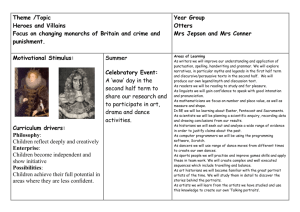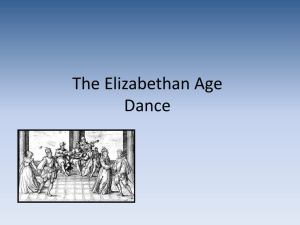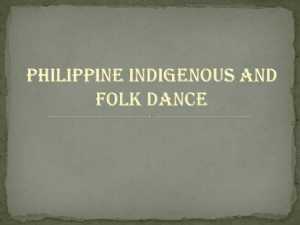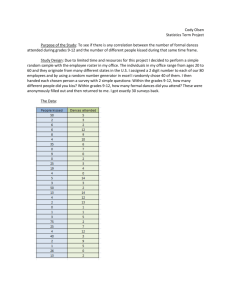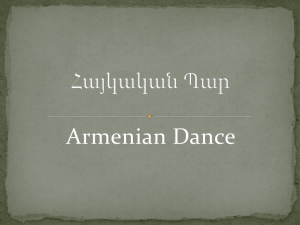Ancient Civilizations
advertisement
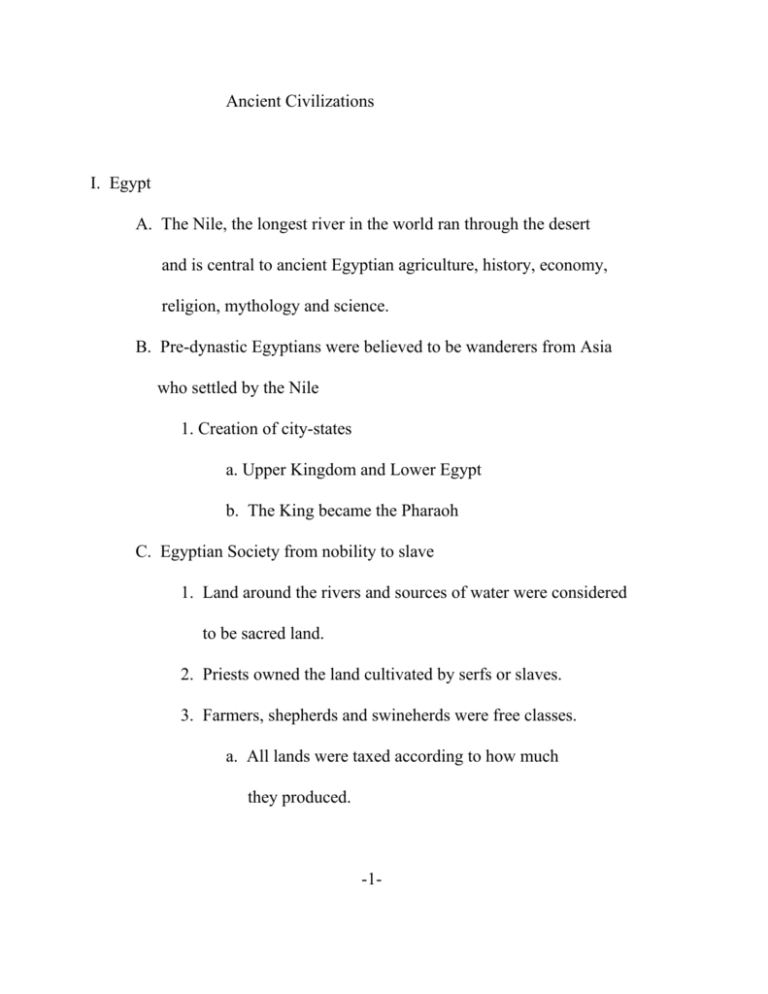
Ancient Civilizations I. Egypt A. The Nile, the longest river in the world ran through the desert and is central to ancient Egyptian agriculture, history, economy, religion, mythology and science. B. Pre-dynastic Egyptians were believed to be wanderers from Asia who settled by the Nile 1. Creation of city-states a. Upper Kingdom and Lower Egypt b. The King became the Pharaoh C. Egyptian Society from nobility to slave 1. Land around the rivers and sources of water were considered to be sacred land. 2. Priests owned the land cultivated by serfs or slaves. 3. Farmers, shepherds and swineherds were free classes. a. All lands were taxed according to how much they produced. -1- 1. Priests were free of taxation. The Pharaoh taxed the temple in order to receive revenue. 4. Egyptians developed an irrigation system, paper, pens, ink, a writing system and a calendar and created libraries to store their writings. D. Dancers. King, priests, virgins and professional dancers were among the major dancers in ancient Egypt. 1. The Pharaoh was the mediator between God and the people and performed secret and ritual dances. 2. Priest, or a leading dancer performed magical dances. Priests were the evolution of the shaman in early societies. a. Complexities of rituals required codification of the correct procedures. 1. Groups of Priests trained in dance and drama trained the next generation. 3. Female Temple Dancers a. Women had four professions from which to select 1. Priesthood -2- 2. Midwifery 3. Mourning 4. Dancing a. Groups of female virgins were trained to perform in ceremonies led by the priests. The virgins were taught by women and performed naked with only flower decorations. 4. Upper class people performed dance in the temple as part of religious worship but not for entertainment. a. Professional dancers and musicians provided entertainment for the upper class. 5. Lower class Egypt participated in pantomime and comic dances linked to harvest and other calendric events including the rise and fall of the Nile. a. Harvest festivals included popular dancing with people carrying canes and sticks and striking them together. 6. Trained dancers first appeared at religious festivals, then at banquets and festivals. -3- a. Male and female performers were trained as musicians, singers, dancers and acrobats by dance masters. 7. Dwarf dancers. Pygmies from Lybia were brought to Egypt during the fourth dynasty to dance for the Pharaohs and it was considered to be good luck for all in attendance. a. The Pygmies performed grotesque dances mimicking clumsy movement which were later a part of funeral ritual dances. 8. Egyptian religion and dance. Dance was the main means of expression in religious services and mysteries and doctrines were communicated through symbolic dance-dramas. a. The most significant dance was about the Nile and was a fertility dance. b. It is assumed there were animal dances but there is no evidence of this. 1. There is pictorial evidence of a dance about wind. 9. Funeral Dances. a. Ritual dances were performed by men and women clapping their hands together rhythmically. -4- b. Postures and gestures that expressed grief. 1. In later dynasties, professional dancers were hired instead of friends and family of the deceased. c. Secular dances. Men and women performed the favorite dances of the deceased nobleman. 10. Dance as Entertainment a. As Egyptian society became more complex, dance developed to include dance as entertainment beyond dance for religious rites. 1. Servants, slaves, Pygmies and trained dancers performed. a. The influence of the slaves brought from other countries changed the dance style from linear to more flowing and closed. b. Solo and group dances were performed. 1. The King performed the Sun dance. 2. Priest appointed by the King also performed solos or led religious dances. -5- 3. The King or an appointed soloist danced at the harvest festival. c. Group dances 1. Competition dances. 2. War dances performed in a circle. d. Pair dancing 1. Two dancers of the same gender performed pair dances as entertainment. a. Evidence of this as early as the sixth dynasty. b. Fifth dynasty dances had symmetrical and dynamic movements and expressed emotions of longing and depression. e. Circle dances 1. As in prehistoric times, circle dances symbolized astronomical themes or fertility. 2. Pairs or ranks of dancers formed two or three circles. f. Line, procession or serpentine dances. -6- 1. Lines and similar formations were used for religious, funeral and entertainment purposes with the musical accompaniment of harps and pipes and hand clapping. g. Dance movements ranged from processional walking to acrobatics and gymnastics. There were also hand gestural dances of the stars and mimetic dances. h. Accompaniment 1. Music was believed to be a spiritual element by the priests and was not as developed as the other arts. a. Egyptian music used seven tones 1. Instruments were the harp, the lyre, guitar, pipes and tambourine. 2. Songs were also sung. a. The oldest preserved record is in 4/4 time with a dancer trainer shouting, “ha, ha ha, ha.” 3. Tempos ranged from slow to lively. i. Costumes and adornment remained unchanged until -7- Greece and Rome conquered Egypt in the first century B.C. 1. Simple for slaves and extravagant for Kings and royalty. a. Dancers seldom wore ordinary clothing for dances. 1. Kilts and aprons were worn by both men and women to allow freedom of movement. b. Women’s hair was braided and under a cap with the braids hanging down to the side. Men were clean shaven and later wore wigs and false beards for dances and ceremonies. c. Henna and kohl were used on hands and eye and both men and women painted their bodies as adornment. II. Ancient Crete- 3000-1400 B.C. The island of Crete and Egypt had their high points at about the same time. The Cretan people are thought to have migrated from Asia minor. -8- A. The Cretans took slaves from the city-state of Athens. 1. Highly-sophisticated culture that was rich in the arts. 2. The people were tall and athletic and lived in harmony with the sea. 3. Archeological digs from 1900 A.D. uncovered the remains of the civilization. a. Collapse of Athens might have been from an earthquake or a volcanic eruption. B. Early Crete 1. Clans or “genos” engaged in agriculture and commerce. 2. Dance was part of everyday life and society. a. Men performed armed dances and funeral dances. b. Women danced in religious and ritualistic ceremonies. c. Both men and women performed bull dances. 1. Central to Cretan mythology was the legend of the Minotaur which a creature that is half man and half bull who ate humans. 3. Dance themes in Crete included military training, healing, religious rituals and entertainment. -9- a. Military dances were for training. b. Medicine men performed harvest and fertility dances with high leaps and shouting to frighten evil spirits away. c. There is historical evidence of women performing skirt dances and dances of snake handling and bull acrobatics. 1. Bull dancing served both as a religious rite and entertainment. Bull dancers or athletes performed acrobatic movements over the back of a bull. Male and female performers grabbed the bull’s horns and somersaulted over its back. Training for bull dancing took about three years and was life-threatening. III. Ancient Greece A. Crete was a stepping stone between Egypt and Greece and each civilization borrowed from the other around the Mediterranean Sea. -10- B. Greece is surrounded on three sides by the Mediterranean and the Aegean Seas. The northern border of Greece connect to both Europe and Asia. C. Early Greeks were nomadic farmers. 1. Communities were ruled by elders, then city-states but not united. 2. Athens and Sparta were the largest and they only united to fight against stronger groups who threatened them. 3. Although not united, the city-states shared religion, language, customs, literature and the Olympic games. 4. The periods in Greek history follow the standard of historical references of periods for civilizations. a. The Dark Ages b. Archaic period c. Classical period d. Hellenistic period 1. Rome conquered Greece 5. During the Classical period, Athens, Greece experienced a vast -11- wave of immigration and the arts flourished. This is called the Golden Age of Greece. a. There was an artificial, ideal form of beauty. 6. Greeks believe man to be a combination of mind and body. a. A person was considered educated if he could dance. b. A person’s moral character was defined by the dances performed. 1. Dances were not what would be considered to be dances today. a. Ordered form, integrated with music and poetry as part of rituals, religion and social life. c. Dionysian cults. Dionysus or Bacchus, was the god of fertility and wine. 1. Men of the cult were known as satyrs and women as maenads. 2. Dancers entered an altered state called “enthousiasmos” and the wild, crazed dances were called “oreibasia.” -12- D. Professional dancers were hired for funerals and feasts. 1. Usually slaves, freeman or foreigners a. nude acrobatics b. animal dances c. burlesque d. Fourth century- professional female dancers wore helmets, shields and carried spears while performing graceful warlike dances. E. Dance was performed for every occasion in Greece. 1. Music scores written for dances with varying tempo and mood. 2. Names of dances a. scattering the barley b. knocking at the door c. the itch 3. Orcheisthai means to dance but is broader than the translation to English. Greek dance was inseparable from music and poetry. a. Terpsichore means “join in the dance.” 4. Plato classified movement into two categories. a. noble was movement of beautiful bodies -13- b. ignoble meant distorted movement c. Diexis was pure dance in which the male dancer portrayed the essence of the human character or an animal or natural element such as fire or wind. 5. Ancient Greeks believed a man’s grace in dance equaled his prowess in battle. a. Greeks celebrated life-span and calendric events. These religious activities later transformed into a theatrical art. 6. Armed dances were part of a young man’s education in Greece. In Sparta, women had military training and performed some of the Men’s military dances to increase strength and endurance for child bearing. 7. Military dance figures and steps a. Formations included circles, diagonals, squares and groups accompanied by a flute. b. Pantomime of the skills used in battle. 8. Weapon and war dances a. Pyrrhic was a form of weapon dance which boys in Sparta began training at the age of five. -14- b. Originally dedicated to Apollo, the dance began with hymns of praise. c. A choragus was a person who sponsored training for competition pyrrhic dances. 9. Animal dances a. Young men and women performed these dances wearing masks and costumes. b. Most important animal dances were bull and cow dances which began as solemn rituals and evolved into entertainment and were sometimes part of comedies. c. Wedding celebrations. 1. In Athens, the bride and groom rode in a cart and the guests danced behind them. 2. In Sparta, women had more equality than men and more freedom than Athens women. In Sparta, the bride and groom danced together. d. Funeral dances. 1. The priest led the procession of friends and family to the tomb of the deceased. Hired mourners gestured -15- grief. Family was permitted to participate in the dance. The ,more participation, the greater the show of strength for the deceased. e. Religious and cult dances. 1. Priests were both men and women. a. Ancient worship included prayer, sacrifice, prophecy, dreams, ecstasy and dance. 10. Dance in Greek Theater a. Dance changed from festival to spectacle. 1. The chorus and the audience separated. b. Dionysian feasts honoring the earth, fertility and vegetation moved from the temple to outdoors in spaces which evolved into theaters. c. Drama was created by a priest of Dionysus named Thespis who was a dancer and singer and added dialogue to the dance while wearing a goat’s mask. 1. Tragedy came into being a. Tragedy translates to “goat’s song.” 11. Theater started in a field and then was performed in a hut. -16- a. Athens had a population of 30,000 and the theater seated 15,000. b. Dionysian festivals included four days for tragedy and three days for comic plays. c. In the transformation to the theater, a circular part of of the path of oxen walking around a post became the orchestra where the chorus performed. 12. Playwrights and poets originally set the dances for their own plays and in the seventh century B.C. Arion of Lesbos taught the chorus steps and gestures. a. The choragus was a rich man who financed the play and trained the chorus. 1. A volunteer acted as assistant to the playwright a. The assistant hired a dance instructor. b. Plays were eleven months in rehearsal. c. Before the play was performed, the choragus and made a sacrifice to Dionysus so the play would be successful. -17- d. Only men were allowed to performed and played both parts of men and women. 1. Dancers were paid in food and costume. e. By the second century, in tragedy, the chorus sang\ but did not dance. 13. Theatrical dances included a. Serious noble dances with the chorus marching and staying on stage during all of play and then marching out in a procession. b. In comedies, actors spoke directly to the audience and the chorus consisted of fewer people with light lively steps. By Roman times, some of the dances had changed to lewd and suggestive dances with hip rolls and suggestive gestures. 14. Performers’ Unions a. The first union for professional poets, actors, trainers, chorus members and musician was called the Artists of Dionysus. 1. The union specified that their members could -18- travel through foreign or hostile states unharmed to give performances and were exempt from compulsive military service and taxes. 2. The Artists traveled toured the classical plays around the Mediterranean area spreading Greek culture. 15. Accompaniment a. At the beginning of a play competition, a trumpet was played. 1. A herald announced as each tribe entered. 2. A flute player walked in with the chorus. 3. The dancers formed a circle around the alter and sang. 16. Dancers’ costumes were less elaborate than actors’ a. Since all of the dancers were men, they wore masks and enhanced breasts and rears. b. The choragus rented the costumes for the performance. 17. Three forms of plays evolved a. tragedy, comedy and satyr -19- b. Tragedies were the most important of the plays. 1. No more than three actors were in each play and they often played multiple roles. 2. Actors used symbolic gestures and struck poses that went with the songs being sung. 3. Comedies and satyrs were parodies of the tragedies and the provided comic relief. 18. In the early part of the 20th century, there was a resurgent interest in Greek antiquity and its dance and performers like Isadora Duncan used this as their inspiration. 19. During the Hellenistic period of Greek, they brought their culture to the Italian peninsula which provided much of the foundation for the development of Roman dance. IV. Rome and the Roman Empire A. The Italian peninsula, west of Greece was a climate and location which provided a strong agricultural society. B. Romans amalgamated the strengths of many cultures to create a ruling power that reigned for more than a thousand years until its collapse at the end of the ancient time period. -20- C. Rome was a Republic that conquered most of the area surrounding the land mass and eventually took all of Greece under its power. Rome continued to expand during years of internal revolution and dominated Egypt, Syria and Asia Minor. D. Rome experienced two hundred peaceful years under the reign of Augustus and during this golden age, art and literature flourished. E. Emperors ruled Rome for more than 500 years and Constantine legalized Christianity. 1. The Empire divided into eastern and western halves and the Catholic Church remained in Rome and the Greek Orthodox in Constantinople. 2. The economic classes of Roman society included nobles, knights and common people. F. Society and the arts 1. The first professors were Greek. a. Latin was the language for law and administration. 2. Aristocrats in Rome spoke Greek. a. Wealthy Romans studied with tutors and the lower classes had only a grade-school education. -21- 1. Visiting teachers taught music and dance. 3. Rome is known for its contribution of pantomime or dancedrama without words. a. The Roman pantomimes wore elaborate costumes and masks. b. An actor summarized the story to be performed and the chorus accompanied by a small orchestra sang songs offstage before and between episodes. G. Dancers and personalities 1. Dance in Rome served a variety of purposes a. religious, social and entertainment 2. There were colleges of twenty-four dancing priests who performed for religious ceremonies and some secular occasions. 3. The upper classes did not dance preferring to be audience a. Evidence does indicate that young aristocrats were trained in dance as part of their education and social graces. 4. Professional dancers, flute players and acrobats were slaves -22- imported from Greece and other conquered nations. 5. Mimes and pantomimes a. Mimes would imitate anything, did not speak, wore masks and sometimes strolled down the street accompanied by a flute player. 6. Theodora was a beautiful actress and dancer and a well-known courtesan. a. Her performances ranged from pantomime to striptease. 1. Many of the court were shocked by this but Justinian who was heir to the throne fell in love with her and convinced his uncle and adoptive father to change the law so that he could marry her. a. Justinian and Theodora became emperor and empress of the Eastern Roman Empire. 7. Dances of Rome a. Dance had a smaller role in Roman life than it did in Athens or Sparta. 1. War dances were preparation for war in mock battle. -23- 2. Religious and dance rites. 1. Greek colonies living in Rome continued the Dionysian festivals. 2. Roman had annual festivals and dance had many purposes in the religious ceremonies of calendric events and to frighten away evil spirits. 3. Games and contests 1. Second century A.D. the Greek games included music and drama contests. 2. Winners of pantomimic dances won 4,000 drachmae (a silver coin of Ancient Greece). 3. During the first century A.D. performers had become corrupt performing erotic, sensational and grotesque dances. a. Women became dancers performing roles that were previously performed by men. -24- b. Condemned criminal were dressed in elaborate costumes treated with a flammable substance and they were forced to dance through amphitheaters and their costumes would burst into flames. c. Many Roman emperors and the public enjoyed these performances, but the Christian church objected to these performances and Marcus Aurelius put a ceiling on dancers pay and production costs in order to discourage this practice. 8. Roman dance in the theater a. Roman theater was influenced by the Greeks 1. The Theater of Pompey was the first permanent theater. 2. By A.D. 550 more than a hundred theaters had been built in Rome with limited seating -25- of a few hundred people and the hall was closed for the audience. 3. Mime was considered part of the actors repertoire using this technique to imitate another person. 4. Pantomime became a highly developed art. 5. The Circus Maximus, completed in 329 A.D. was the largest and most famous amphitheater. a. Dancers performed in circus shows and dramatic interludes along with musicians. 9. Roman literature flourished during this time but the greatest impact Rome may have had on the theater was to lower it in the esteem of the church which stymied the growth of the dramatic arts for years. -26-
